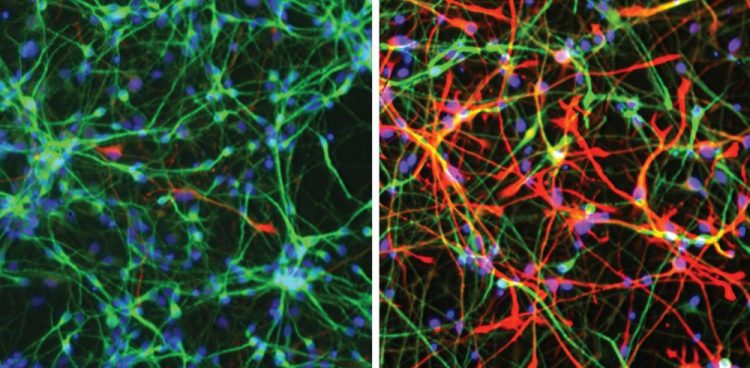Power up: growing neurons undergo major metabolic shift

Salk Institute researchers have now identified the timing of a dramatic metabolic shift in developing neurons, which makes them become dependent on oxygen as a source of energy. A key metabolic pathway must be switched off during neuron development, or else -- as is shown on the right -- fewer neurons (green) survive. The red cells are non-neural cells called glia. Credit: Salk Institute
The findings, published July 12 in the journal eLife reveal a metabolic route thought to go awry in cancer and neurodegenerative diseases, such as Alzheimer's and Parkinson's disease.
“There is relatively little understanding about how neuron metabolism is first established,” says co-senior author Tony Hunter, holder of the Renato Dulbecco Chair and American Cancer Society Professor in Salk's Molecular and Cell Biology Laboratory. “Aside from enabling us to understand this process during neuronal development, the work also allows us to better understand neurodegenerative disease.”
To send messages along neurons is energetically demanding, and the brain uses both oxygen and glucose intensely. The brain, for example, uses 20 percent of the body's glucose supply. The cell's energy-producing factories, called mitochondria, are scattered throughout the long, slender axons of neurons in order to provide all parts of the cell with a constant supply of energy. As the neurons get bigger, so do the number of mitochondria, according to the new study.
We make new neurons in the womb, and this process continues after birth. Even a few areas in the adult brain continue to make new neurons throughout life. “We assume that the metabolic shift we describe in this new study happens every time a progenitor cell turns into a neuron,” says the study's first author Xinde Zheng, a Salk research associate.
The cells that eventually become neurons initially use a pathway called glycolysis, which is a major energy-producing process that takes place in the cytoplasm of the cell and turns glucose into energy in the form of adenosine triphosphate (ATP). At some point, however, the cells switch to a more efficient pathway called oxidative phosphorylation, a process that uses oxygen to produce ATP and occurs inside the mitochondria.
Hunter, Zheng, Salk's Leah Boyer and colleagues previously studied a rare metabolic disease called Leigh syndrome and recently published work showing that less ATP is produced in afflicted neurons. In the process of understanding that disease, they needed to recreate it in a dish, using cells with mutations in the DNA contained within mitochondria. But the team realized that it was not well understood how normally dividing cells generate energy while they divide and differentiate into new cell types.
In the new study, Hunter's team found that as a neuron precursor cell becomes a neuron, genes coding for key metabolic enzymes used in glycolysis switch off their expression,. Those changes work hand in hand to shut down glycolysis. All the while, key regulators of oxidative phosphorylation are ramping up.
Most surprising is that developing neurons must completely shut down glycolysis, says Hunter. When the researchers prevented that from happening, the neurons quickly died.
“This is the first comprehensive analysis of metabolic changes during neuronal differentiation, and the surprising reliance of neurons on oxidative phosphorylation for their sole energy source has clear implications for neuronal vulnerability with age,” says co-senior investigator Rusty Gage, a professor in Salk's Laboratory of Genetics and holder of the Vi and John Adler Chair for Research on Age-Related Neurodegenerative Diseases.
The group plans to look more closely at how the metabolic genes are controlled in developing cells. They also plan to study neurons harboring energy defects associated with disease, such as Parkinson's disease, and different types of neurons to compare any finer differences in metabolism.
###
Other authors on the study are Mingji Jin, Jerome Mertens, Yongsung Kim, Li Ma, Li Ma, and Michael Hamm, all of the Salk Institute.
The research was supported by the National Institutes of Health, the G. Harold and Leila Y. Mathers Charitable Foundation, the JPB Foundation, the Leona M. and Harry B. Helmsley Charitable Trust, Annette Merle-Smith, the California Institute for Regenerative Medicine, and the Helmsley Center for Genomic Medicine.
About the Salk Institute for Biological Studies:
Every cure has a starting point. The Salk Institute embodies Jonas Salk's mission to dare to make dreams into reality. Its internationally renowned and award-winning scientists explore the very foundations of life, seeking new understandings in neuroscience, genetics, immunology and more. The Institute is an independent nonprofit organization and architectural landmark: small by choice, intimate by nature and fearless in the face of any challenge. Be it cancer or Alzheimer's, aging or diabetes, Salk is where cures begin. Learn more at: salk.edu.
Media Contact
All latest news from the category: Life Sciences and Chemistry
Articles and reports from the Life Sciences and chemistry area deal with applied and basic research into modern biology, chemistry and human medicine.
Valuable information can be found on a range of life sciences fields including bacteriology, biochemistry, bionics, bioinformatics, biophysics, biotechnology, genetics, geobotany, human biology, marine biology, microbiology, molecular biology, cellular biology, zoology, bioinorganic chemistry, microchemistry and environmental chemistry.
Newest articles

Combatting disruptive ‘noise’ in quantum communication
In a significant milestone for quantum communication technology, an experiment has demonstrated how networks can be leveraged to combat disruptive ‘noise’ in quantum communications. The international effort led by researchers…

Stretchable quantum dot display
Intrinsically stretchable quantum dot-based light-emitting diodes achieved record-breaking performance. A team of South Korean scientists led by Professor KIM Dae-Hyeong of the Center for Nanoparticle Research within the Institute for…

Internet can achieve quantum speed with light saved as sound
Researchers at the University of Copenhagen’s Niels Bohr Institute have developed a new way to create quantum memory: A small drum can store data sent with light in its sonic…





















